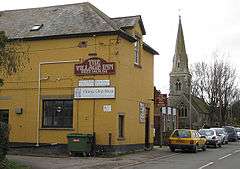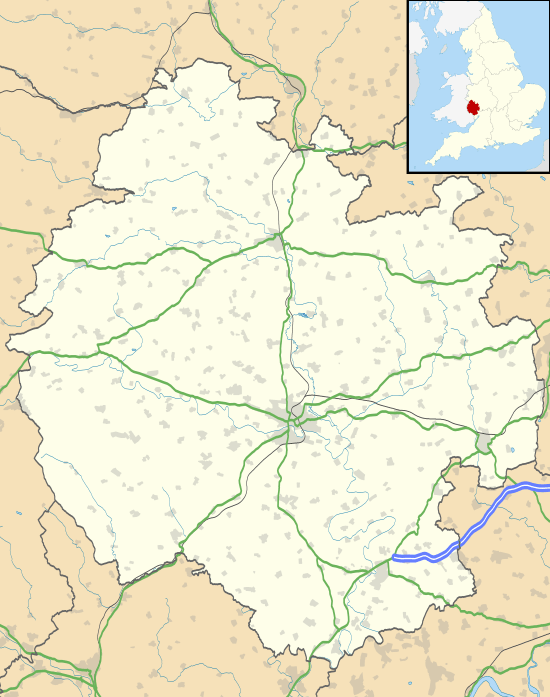Moreton on Lugg
Moreton on Lugg is a village in Herefordshire, England, between Hereford, 4.25 miles (6.84 km) to the south, and Leominster, to the north.[1]
| Moreton on Lugg | |
|---|---|
 The Village Inn with St Andrews Church in background | |
 Moreton on Lugg Location within Herefordshire | |
| Population | 920 (2011 Census) |
| Unitary authority | |
| Shire county | |
| Region | |
| Country | England |
| Sovereign state | United Kingdom |
| Post town | Hereford |
| Postcode district | HR4 |
| Police | West Mercia |
| Fire | Hereford and Worcester |
| Ambulance | West Midlands |
| UK Parliament | |
The village lies between the A49 trunk road and the Welsh Marches railway line. At the 2001 Census, the population of the village was 952,[2] which had decreased to 920 by the time of the 2011 Census.[3]
The village was mentioned in the Domesday Book as being in the Hundred of Cutestornes and having eight villagers and five slaves.[4] The name derives from Old English Mōr-tūn (town by a fen), and its proximity to the River Lugg.[5] In Medieval times, the village was listed as Morton Juxta Logge.[6] The village had a railway station on the Welsh Marches Line that operated between December 1853 and June 1958.[7] In the early days of railway operation, the railway station at Moreton was famous for having the ticket office situated in a huge hollow oak tree with a circumference of 62 feet (19 m).[8][9]
The Church of St Andrew is a grade II listed structure that was built around the 15th century but was renovated in 1867.[10] The church is tied in a benefice with the Church of St Peter at Pipe and Lyde.[11]
On the other side of the River Lugg, lies Freens Court, investigated by TV programme Time Team in 1999 as a possible site for the Saxon palace of King Offa. The dig confirmed the existence of a large aisled building but it was thought to date from the mediaeval period.[12]
An area north of the village around SO505477 was used for many years by the Royal Army Ordnance Corps for the storage of surplus materials, including the decorations from the investiture of the Prince of Wales.[13] The internal railway at the RAOC site was used for training SAS troops to attack railway carriages.[14] When the RAOC site closed in the early 2000s, it was bought by Greatwest Investments Limited for development into a business park.[15]
References
- "History of Moreton on Lugg in Herefordshire | Map and description". www.visionofbritain.org.uk. Retrieved 7 March 2020.
- UK Census (2001). "Local Area Report – Moreton on Lugg Parish (00GA154)". Nomis. Office for National Statistics. Retrieved 7 March 2020.
- UK Census (2011). "Local Area Report – Moreton on Parish (E04000835)". Nomis. Office for National Statistics. Retrieved 7 March 2020.
- "Moreton [-on-Lugg] | Domesday Book". opendomesday.org. Retrieved 7 March 2020.
- Ekwall, Eilert (1947). The concise Oxford dictionary of English place-names (3 ed.). Oxford: Clarendon Press. p. 315. OCLC 12542596.
- The place-names of Herefordshire at the Internet Archive
- Quick, Michael (2019). "Railway Passenger Stations in England, Scotland and Wales; a Chronology" (PDF). rchs.org.uk. p. 287. Retrieved 7 March 2020.
- Simpson, Helen (1997). The Day the Trains Came. Gracewing. p. 47. ISBN 978-0-85244-374-3.
- Howse, Christopher (18 November 2009). "Railway stations have turned into little hells". The Daily Telegraph. Retrieved 7 March 2020.
- Historic England. "Church of St Andrew (Grade II) (1099254)". National Heritage List for England. Retrieved 7 March 2020.
- "Moreton-on-Lugg: St Andrew - A Church Near You". www.achurchnearyou.com. Retrieved 7 March 2020.
- Morris, Ian (8 December 2017). "Archaeologist enters debate over exact site of King Offa's Herefordshire palace". Hereford Times. Retrieved 7 March 2020.
- "BLS - Fixture Reports". www.branchline.uk. Retrieved 7 March 2020.
- Jackson, Allen (2015). Contemporary Perspective on GWR Signalling : Semaphore Swansong. Marlborough: Crowood. Fig 178. ISBN 978-1-84797-950-6.
- "Denco to move to Moreton-on-Lugg". Hereford Times. 28 August 2003. Retrieved 7 March 2020.
Sources
Michael Raven, Guide to Herefordshire, 1998, ISBN 0-906114-22-5
External links
| Wikimedia Commons has media related to Moreton on Lugg. |